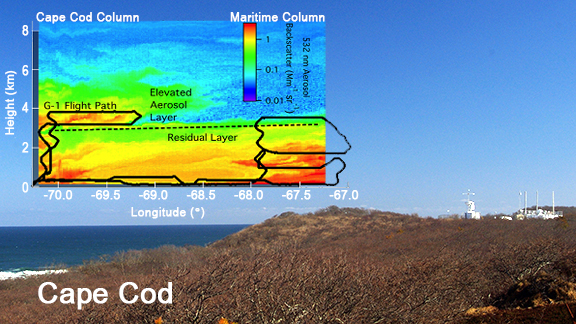Two-Column Aerosol Project: Impact of Elevated Particle Layers on Particle Optical Depth
Submitter:
Berg, Larry — Pacific Northwest National Laboratory
Area of research:
Aerosol Properties
Journal Reference:
Science
A group of DOE-funded scientists on an ARM field campaign discovered elevated levels of aerosols even on Cape Cod's cloud-free days—and these aerosols have a large impact on the amount of sunlight reaching the surface. The year-long study included measurements to examine the chemical composition of the particles, the way they reflect or scatter light, and their ability to act as seeds for cloud drops.
Impact
Aerosols can be surprisingly complex. They range in size from almost invisible to extremely tiny. They can come from sea spray, dust, and car exhaust, among other sources. They can join up in the air, change their chemical composition, and mix with other particles. All of these changes can affect how they interact with the atmosphere. The data gathered during the Two-Column Aerosol Project will go a long way toward narrowing that range of possible answers.
Summary
The scientific team from national laboratories and universities sampled a column of air in two locations, one fixed over the Cape Cod National Seashore and the other over the Atlantic Ocean more than a hundred miles from the coast. Two aircraft (including the ARM Facility's Gulfstream) equipped with scientific instruments flew through the columns on simple, repeatable flight patterns, with close coordination, so data could be effectively compared over time and space. Additional instruments, deployed at the Highlands Center at the Cape Cod National Seashore, took measurements at the base of the column on Cape Cod.
Scientists also made use of new instruments, which were deployed for the first time during the project:
- miniSPLAT, a single-particle mass spectrometer developed for the ARM Facility, which can measure the size and chemical composition of individual aerosol particles from inside the plane
- NASA's Spectrometer for Sky-scanning Sun-Tracking Atmospheric Research (4STAR) mounted on the roof of an aircraft to measure small changes in the amount of sunlight associated with particles in the atmosphere
- NASA's second-generation High Spectral Resolution Lidar (HSRL-2) to characterize clouds and measure aerosol distribution and movement from a high-altitude aircraft.
The new instruments and data obtained from the in-air sampling gave scientists an unprecedented look at aerosol chemical and other properties off the east coast of the United States.


